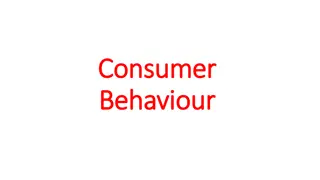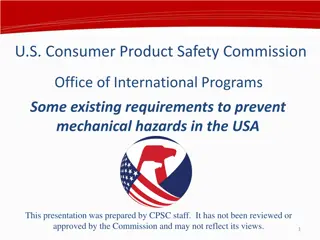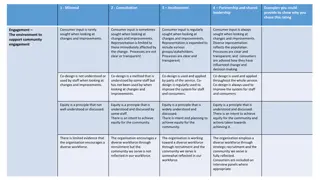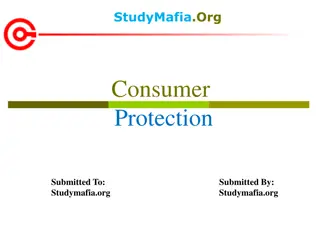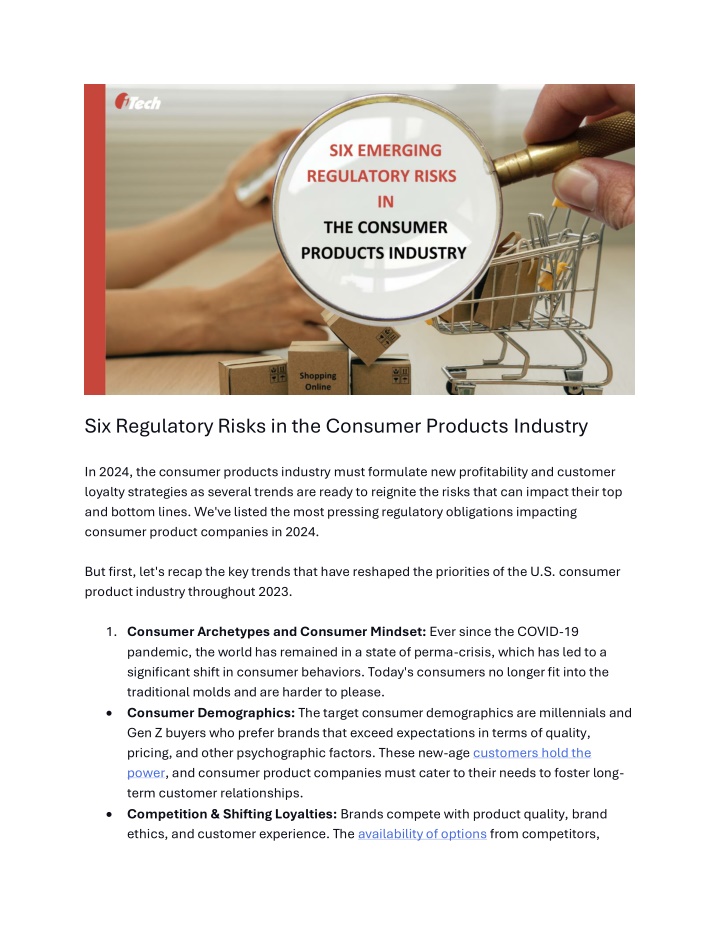
Six Regulatory Risks in the Consumer Products Industry
In 2024, the consumer products industry must formulate new profitability and customer loyalty strategies as several trends are ready to reignite the risks that can impact their top and bottom lines. Let's delve into the most pressing regulatory oblig
Download Presentation

Please find below an Image/Link to download the presentation.
The content on the website is provided AS IS for your information and personal use only. It may not be sold, licensed, or shared on other websites without obtaining consent from the author. If you encounter any issues during the download, it is possible that the publisher has removed the file from their server.
You are allowed to download the files provided on this website for personal or commercial use, subject to the condition that they are used lawfully. All files are the property of their respective owners.
The content on the website is provided AS IS for your information and personal use only. It may not be sold, licensed, or shared on other websites without obtaining consent from the author.
E N D
Presentation Transcript
Six Regulatory Risks in the Consumer Products Industry In 2024, the consumer products industry must formulate new profitability and customer loyalty strategies as several trends are ready to reignite the risks that can impact their top and bottom lines. We've listed the most pressing regulatory obligations impacting consumer product companies in 2024. But first, let's recap the key trends that have reshaped the priorities of the U.S. consumer product industry throughout 2023. 1.Consumer Archetypes and Consumer Mindset: Ever since the COVID-19 pandemic, the world has remained in a state of perma-crisis, which has led to a significant shift in consumer behaviors. Today's consumers no longer fit into the traditional molds and are harder to please. Consumer Demographics: The target consumer demographics are millennials and Gen Z buyers who prefer brands that exceed expectations in terms of quality, pricing, and other psychographic factors. These new-age customers hold the power, and consumer product companies must cater to their needs to foster long- term customer relationships. Competition & Shifting Loyalties: Brands compete with product quality, brand ethics, and customer experience. The availability of options from competitors,
direct-to-customer (D2C) business models, and multi-channels for purchase make customer experience a top priority to improve customer satisfaction and loyalty. 2.Reverse Impact of Price Increase on Profit Margins: Increased price hikes to combat cost inflation led to 10% growth in global sales volumes in 2023. Market trends slash that notion of pricing to drive profitability in the consumer products industry and recommend switching to a profitable volume strategy, product innovation, and sustainability. 3.Brand Sustainability Missions Impacts Consumers: A McKinsey U.S. Consumer Sentiment Survey revealed that 60% of consumers are reportedly willing to pay extra for a product with sustainable packaging. Consumer products with ESG- related claims have earned 28% cumulative growth. As the trends shift towards sustainability, half of the global consumers are ready to pay a premium for products with environmentally friendly objectives, circular economy models, and ESG practices. 4.Increased Digital Transformation: Against inflationary pressure and economic uncertainties, many consumer product companies are investing in technology solutions to optimize costs and production volume. Data transparency, process visibility, automation, and transformative digitization enable consumer products brands to exceed customer expectations while focusing on tech modernization. 5.Cybersecurity and Data Privacy Concerns: With increased omnichannel activity and concerns around companies using third-party data, companies are prioritizing data protection and cybersecurity risk management. Additionally, industry-related cybersecurity incidents have impacted the consumer products industry's supply chains and production lines. These further amplify the urgency to manage and uphold the industry's protection and regulatory compliance obligations to prevent third-party risks, cybersecurity incidents, and brand reputational damage. 6.AI and GenAI-led Competitive Differentiation: Customer-centricity and customer experience factors add to a consumer products brand's competitive edge. Many businesses in the consumer product and goods industry strive to maximize AI and GenAI integration to enhance productivity and mitigate new risks. With these trends shaping the consumer products industry, businesses and brands are pulled into the evolving regulatory events and legal compliance framework puzzle. To avoid
non-compliance risk, iTech GRC's expert team adopts a focused approach to risk assessment and mitigation. Using 20+ years of expertise in aiding GRC strategies of large and leading enterprises, our IBM-certified GRC professionals deliver GRC tools for the consumer goods industry like OpenPages. We have curated their insights about the emerging legal risks that companies in the consumer products industry must proactively address in 2024. Emerging Regulations in the Consumer Product Industry 1.Federal Trade Commission's Recent Consumer Protection Rules: The Federal Trade Commission (FTC) introduced several consumer protection regulations, and most of these law enforcement (90%) targeted the financial services industry, telecoms, healthcare, digital and web services, and retail sector. The retail industry had nearly 26 enforcements addressing product labeling, brand marketing and endorsement strategies, consumers' right to repair, and data privacy management. The most recent updates to FTC's rules include: Removal of Hidden and Junk Fees: The FTC ruled that most consumers are unaware of hidden fees until the end of the transaction, and these charges cost
customers nearly $10 billion annually. The agency proposed eliminating hidden and junk fees. Recurring Payment Services: According to the agency, recurring payment methods and online automated subscriptions are swift and seamless for both customers and service providers. However, they are mostly exploited. The FTC revisited its existing regulation on recurring payments regarding subscription cancellations and tracking of payment reminders and renewal processes. Guidelines on Online Customer Reviews: The FTC rules that businesses must practice transparent and fair review-related practices and pay attention to the principles under FTC Act sec. 5 to earn customer trust and curb deceptive practices. The agency also offers guidance on how a company processes, moderates, and publishes customer reviews and review narratives online. 2.Proposition 65: California Proposition 65 regulates the release of hazardous chemicals and toxic contamination of drinking water sources by manufacturing and production companies. Originally known as the Safe Drinking Water and Toxic Enforcement Act of 1986, the law mandates all California manufacturers to disclose the presence of toxins and chemicals to local residents. The law applies to the retail, confectionary, baked goods, automated parts, personal care products, nutraceutical, and fashion merchandise industries. More industries in the state are slated to be governed under Proposition 65 in 2024. 3.Corporate Transparency Act (CTA): The newly introduced CTA Act of 2024 requires individuals forming corporations and limited liability companies (LLCs) to disclose their beneficial owners. This regulation protects corporations and LLCs from criminal gains, money laundering, and other legal misconduct. 4.California Labor Code: Starting July 01, 2024, U.S. employers must update their policies regarding employee background verification, data privacy, workplace safety, and fair pay to ensure compliance with the California Labor Code (CLC). Under the CLC 6401.9, employers in California must implement a Workplace Violence Prevention Plan as a part of their Injury and Illness Prevention Plan. OSHA is building a comprehensive standard that must be approved by the California Occupational Safety and Health Standards Board (OSHSB) before December 2025. 5.California Invasion of Privacy Act: Over the recent months, several litigations have been against companies and website operators using chatbots for customer engagement and communication. Under the California Invasion of Privacy, Act (CIPA) use of chatbot technology constitutes 'eavesdropping' as it carries a record of customer conversation, violating customers' privacy. The statutory penalties were levied on the grounds that chatbot services are provided by third parties or
website operators who can store the conversation using the chat feature, unlawfully accessing customer conversation. 6.California Safety Laws and Recent Enactments: Recently, the Golden State saw the enactment of trendsetter regulations such as the California Food Safety Act, amendments to the Toxic-free Cosmetic Act of 2020, and others. California legislative session enacted climate regulations such as the Climate Corporate Data Accountability Act, Climate-related Risk Disclosures for businesses with $500 million in yearly revenue, and Disclosures Regarding Voluntary Carbon Offsets, NetZero, and Carbon Neutrality Claims. We have touched upon the imminent regulatory non-compliance risks. Stay tuned for more updates on regulatory risk management in the consumer goods manufacturing industry. If you want to achieve a centralized view of your enterprise risk using the AI-powered OpenPages with Watson, our experts can help you evaluate and move from an abstract idea to a concrete GRC plan.



